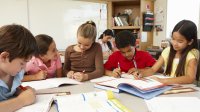3 Ways to Integrate SEL Into the Curriculum
To ensure that social and emotional learning has the greatest impact on learning, embed SEL in academic instruction.
Your content has been saved!
Go to My Saved Content.Teachers have taken many steps to address the social and emotional needs of their students. SEL skills, however, are often taught in a way that’s isolated from content-area instruction. Students may begin their day, for example, with a morning meeting or advisory class, or they may participate in a mindful moment.
How can schools integrate social and emotional practices into academic instruction where they can have the greatest impact on learning? Here are three simple strategies for making SEL a part of the curriculum.
Questions
An easy way to get started is through questions that bring students’ attention to how the SEL competencies of self-awareness, self-management, social awareness, relationship skills, and decision-making exist in what they’re learning. When students read literature, they can examine the characters through a social and emotional lens. For example, the questions How do the characters share their emotions in positive ways? and What can you learn from them? focus students on the SEL competency of self-awareness.
When students learn about leaders or historical events in social studies, human interactions with the environment, or applications of scientific findings, it focuses them on the SEL competency of decision-making. Students can discuss questions such as What did these individuals need to consider when making decisions? What were the results of these decisions? What can you learn about decision-making from these experiences?
Questions bring students’ attention to their mindset and its role in learning. For example, during mathematics, teachers can ask students, What do you need to do to persevere when solving a multistep math problem? How can you use what you know to approach a new and unfamiliar problem? and What can you learn from your mistakes?
Questioning is also important for prompting students to reflect on their use of social and emotional skills and strategies. Asking students, How did (the strategy) help you to (e.g., manage your emotions, interact with your peers, make a responsible decision)? and What would you do differently next time? can make students more aware of how they’re using SEL skills and strategies and what they can do to improve upon their use in different situations.
Self-management tools
Teachers utilize many different methods to gauge student understanding and ensure that students can follow directions and complete the task at hand. Students, however, aren’t always given the tools they need to solve problems, figure out the next steps on their own, or communicate when they need assistance. The following two strategies encourage student independence and ownership of the learning process.
Tool #1: 1, 2, 3, Then Me lays out steps for students to follow and plan how to approach a task. Give students the following:
- One minute to go over the directions silently
- Two minutes to discuss the directions with each other
- Three minutes to plan their approach to the task
Only then can the students ask for assistance.
Tool #2: The Colored Cups tool serves as a communication method that students control to indicate when they need assistance, clarification, or further instruction.
- Green cup: I am/we are fine—no teacher help needed.
- Yellow cup: I/we need teacher help but can continue working while waiting for it.
- Red cup: I/we need teacher help immediately and have stopped working.
Discussion
Classroom discussions are an integral part of learning and provide students with an opportunity to develop social awareness and build relationships. To do so, classroom discussions need to support students’ ability to recognize and consider the feelings and perspectives of their classmates and interact with each other in positive ways.
Students can develop this level of awareness when they identify criteria for discussion, actively use the criteria during discussion, and then reflect and set goals for future discussions.
- Develop criteria. Students independently answer the questions What would you see during a quality discussion? and What would you hear during a quality discussion? Students share their thinking in small groups and identify three criteria they have in common. Each group reports out to create a class list of criteria to guide classroom discussion.
- Test the criteria. Guide students through a process in which they test the criteria to ensure that it allows all student voices to be heard. First, a small group participates in a fishbowl discussion while the rest of the class observes. The class notes how the group followed the criteria and what additional criteria could be added so that each student has a chance to speak and have their contributions to the discussion acknowledged.
All students test the revised criteria when they engage in small group discussions. The groups analyze their experiences and make suggestions for any additional revisions that may be needed. The discussion criteria then become part of the classroom discussion routine.
It’s important that during this phase, the teacher brings attention to the perspective and feelings of students who may not have participated in the conversation, as well as what happens when one student speaks too much without listening to others. The teacher can use a discussion map so that students can visualize the balance of participation in their discussion groups.
- Reflect. Students reflect on what they did well and where they can improve, both individually and as a group. Reflections serve as goals for future discussions and become a routine component of classroom discussions.
Simple protocols such as “Shining Moment or Shout Out” provide a way for students to acknowledge the contributions of peers during the discussion and help further build their relationships.
Integrating SEL into classroom instruction makes students cognizant of how SEL exists in the world around them, how they can use SEL skills to grow as learners, and how, in the long term, these skills help them to become independent, self-regulated learners.
